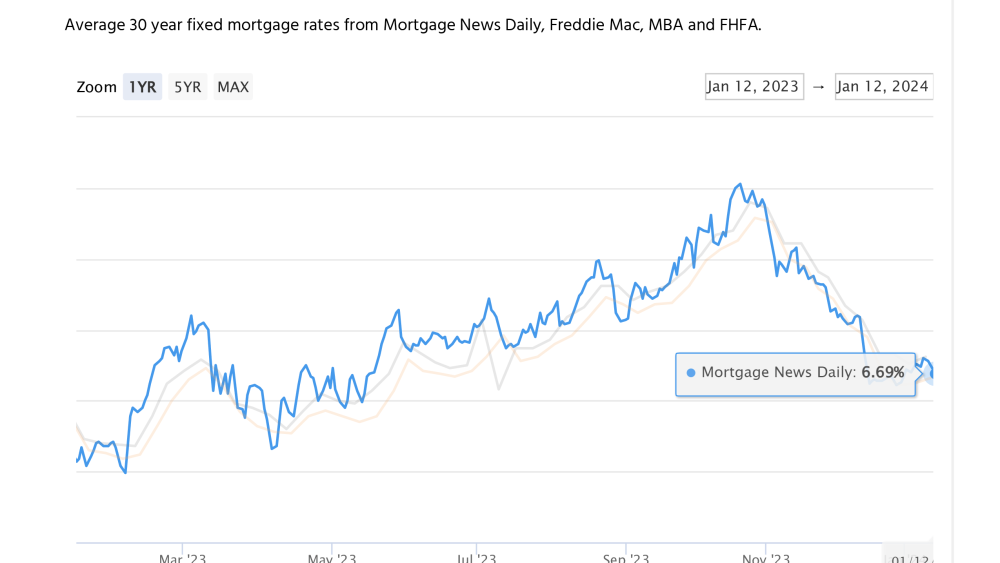In promising developments, economists express reasonable confidence in the likelihood of upcoming rate reductions, possibly as early as March 2024 and with even higher probability in May 2024. The extent of these cuts, along with their timing and frequency, is contingent upon various factors, including inflation and other economic conditions.
1. Housing Prices Shift
Just like a seesaw adjusts when you add weight to one side, lower interest rates usually mean lower mortgage rates. That’s good news because it makes owning a home more doable for more people. Sure, it might nudge housing prices up a bit, which is awesome if you’re selling. But if you’re on the hunt for a home, things are looking up! With lower monthly mortgage payments, those higher prices suddenly seem less scary. This affordability boost could really liven up the housing scene. People who were on the fence about buying might now find it more doable. Keep in mind, though, prices might take a little dip if there are more sellers than buyers. It’s all a bit of a balancing act!
2. Decrease in “Rate Lock-in’s”
While interest rates showed a steady increase in 2022 and 2023, homeowners who secured favorable rates in 2020 and 2021 (below 4%, and even below 3%) felt a sense of commitment, hesitating to relinquish their low rates in the face of rates nearing 8%. As rates potentially experience a decline again, though not reaching previous lows, and these homeowners have accumulated additional equity, there may be an increased willingness to consider selling.
It’s crucial to acknowledge that financial considerations are not the sole driving force behind a decision to move. Other factors, such as job relocation, the need for more space due to a growing family, or a preference for a different neighborhood for lifestyle reasons, also play significant roles.
3. Market Stability Among Increasing New Construction & Resale
Surprisingly, we’ve had a pretty stable and balanced market in the past year or so. There were fewer homes up for grabs, and fewer folks were on the house-hunting hunt. Now, as more homeowners are warming up to the idea of selling, the inventory is on the rise, just as more buyers are stepping back into the market. This double move is like the dance that keeps the seller-buyer equilibrium going strong.
It’s not necessarily going to be a one-sided “seller’s market” or “buyer’s market.” Both parties can score some wins here. A big player in the housing prices game is the inventory available for buyers to choose from. It’s the classic supply vs. demand situation! The good news is, if seller vibes are throwing things off, new construction homes can be a game-changer. You can artificially boost inventory, likely putting a downward spin on prices. While there was a dip in building permits in Northern Colorado in 2023, nationwide, new construction is expected to pick up. Economic conditions are improving, and more buyers are joining the party.
4. Building Competition
The drawback of waiting for interest rates to decline is the widespread adoption of the same strategy by many. This is anticipated to intensify competition in 2024, particularly during the spring and summer months when heightened competition is already expected. The result may manifest as bidding wars, compelling buyers to surpass their initially budgeted amounts. However, this scenario bodes well for sellers, potentially leading to a reduced time on the market and more appealing offers.
Regardless of your position, the guidance of an experienced real estate agent proves invaluable in navigating the intricacies of a fiercely competitive market.
5. Refinancing Possibilities
Even if your plans don’t involve buying or selling in 2024, here’s some positive news for you! If you made a home purchase when interest rates were at their peak in the last couple of years, there’s a chance to explore refinancing your current mortgage in 2024. While the dip might not be massive, it could still lead to a notable reduction in your monthly payment. Be sure to connect with your lending team or reach out to us for some referrals.


